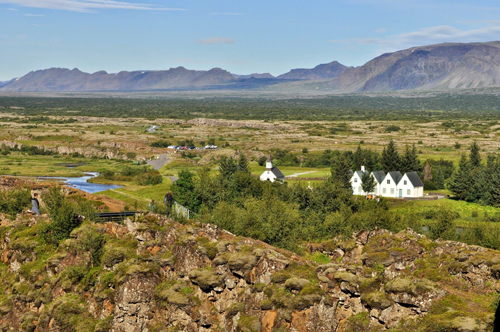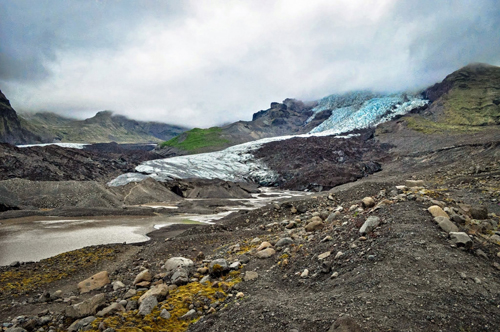Iceland
At A glance
Capital City: Reykjavik
Land size: 100,250 sq km
Population: 357,603 (2022 est.)
Official language: Iclandic
Currency: Icelandic króna (kr / ISK)
UNESCO properties and sites:
- Þingvellir National Park
- Surtsey
- Vatnajökull National Park - Dynamic Nature of Fire and Ice
Source: https://www.cia.gov/the-world-factbook/countries/iceland/
Iceland will strike you with its otherworldly landscapes, natural wonders, and Viking heritage. Explore the vibrant capital city of Reykjavik, with its colorful houses, lively cultural scene, and proximity to stunning natural attractions. Discover the dramatic landscapes of the Golden Circle, where geysers erupt, powerful waterfalls cascade, and tectonic plates meet. Immerse yourself in the warm hospitality of the Icelandic people, experiencing their traditions, relaxing in geothermal hot springs, and perhaps even catching a glimpse of the mesmerizing Northern Lights.
Embark on an extraordinary horse riding adventure through Iceland. Ride through the enchanting valleys and lava fields of Iceland's countryside, feeling a deep connection with the land and its spirited horses. Venture into the ethereal beauty of the Icelandic Highlands, with its rugged mountains, vast glaciers, and pristine wilderness, creating a paradise for horseback riding adventures. Experience the distinctive tölt gait as you traverse meadows, cross glacial rivers, and marvel at the breathtaking waterfalls that adorn the Icelandic landscape. Get ready to create lifelong memories as you uncover the soul of Iceland from the back of a horse, forging unforgettable connections with nature.
Brief History
Settled by Norwegian and Celtic (Scottish and Irish) immigrants during the late 9th and 10th centuries A.D., Iceland boasts the world's oldest functioning legislative assembly, the Althingi, established in 930. Independent for over 300 years, Iceland was subsequently ruled by Norway and Denmark.
Fallout from the Askja volcano of 1875 devastated the Icelandic economy and caused widespread famine. Over the next quarter century, 20% of the island's population emigrated, mostly to Canada and the US. Denmark granted limited home rule in 1874 and complete independence in 1944.
The second half of the 20th century saw substantial economic growth driven primarily by the fishing industry. The economy diversified greatly after the country joined the European Economic Area in 1994, but Iceland was especially hard hit by the global financial crisis in the years following 2008.
The economy is now on an upward trajectory, fueled primarily by a tourism and construction boom.
Source: https://www.cia.gov/the-world-factbook/countries/iceland/
Cultural Insights
Social interaction is egalitarian. Public comportment is quiet and reserved.
Despite today’s globalized world of modern age technology and electronic media, there are ancient folklore beliefs that are alive and well in Iceland. Surveys show that more than half the nation believes in elves and ‘hidden people,’ or at least don’t deny their existence. (It’s considered bad luck to do so)
Source: https://www.everyculture.com/Ge-It/Iceland.html
https://www.icelandtravel.is/about-iceland/culture/
Transportation
By Air
Keflavik International Airport is the main port of arrival for visitors to Iceland. It was built by the U.S. military during World War II and opened on 23 March in 1943. The new terminal building opened in 1987.
In total, there are 28 airline companies flying to and from Iceland during summer months.
Source: https://www.isavia.is/en/keflavik-airport/about-kef
Money
Credit cards are widely used.
Icelandic Kronur are available through banks and cash machines in Iceland although some foreign banks require advance notice before allowing debit or credit cards to be used in Iceland.
Source: https://www.gov.uk/foreign-travel-advice/iceland
Health
If you need emergency medical assistance during your trip, dial 112 and ask for an ambulance. For non-emergency medical assistance in the Reykjavik metropolitan area, dial 544-4114 during business hours. During non-business hours, dial 1770.
If you are referred to a medical facility for treatment, you should contact your insurance/medical assistance company immediately.
There is a medical center or hospital in all major cities and towns in Iceland.
Medical care in Iceland is of high quality, but limited services are available outside large, urban areas. Non-residents are expected to pay their own medical costs, and you should be prepared to pay your bill in full before leaving the hospital or clinic.
If traveling with prescription medication, check with the government of Iceland to ensure the medication is legal in Iceland. Always carry your prescription medication in original packaging with your doctor’s prescription.
Source: https://www.gov.uk/foreign-travel-advice/iceland
https://www.visiticeland.com/article/practical-information1
https://travel.state.gov/content/travel/en/international-travel/International-Travel-Country-Information-Pages/Iceland.html
Electricity
Iceland operates on a 230V supply voltage and uses type C and F plugs.
The Type C electrical plug (or Europlug) is a two-wire plug that has two round pins. It fits into any socket that accepts 4.0 – 4.8 mm round contacts on 19 mm centres. They are being replaced by E, F, J, K or N sockets which work perfectly with Type C plugs.
The Type F electrical plug (also known as a Schuko plug) has two 4.8 mm round pins spaced 19 mm apart. It is similar to the Type E plug but has two earth clips on the side rather than a female earth contact. The CEE 7/7 plug was developed to work with sockets E and F and has grounding clips on both sides (to work with Type F sockets) and a female contact (to accept the grounding pin of the type E socket).
Source: https://www.iec.ch/world-plugs
Communication
Time zone in Iceland: Greenwich Mean Time (GMT)
International country code – 354
Iceland has one of the smallest yet most progressive telecom markets in Europe. The country aims to provide a fixed broadband service of at least 100Mb/s to 99.9% of the population by the end of 2021, an ambitious target by international standards and one which it is likely to achieve given the progress which operators have made in extending the reach of fiber networks.
There is effective competition in the mobile and broadband markets, with a number of players having emerged to challenge the dominance of the two leading operators which have interests across the telecom sectors.
Source: https://www.cia.gov/the-world-factbook/countries/iceland/
Phrasebook
| English |
Icelandic |
| Hello! |
Halló |
| Goodbye |
Bless |
| Good morning |
Góðan daginn |
| Good evening |
Gott kvöld |
| Good night |
Góða nótt |
| Please |
Vinsamlegast |
| Thank you |
Takk |
| Yes |
Já |
| No |
Nei |
Source: https://www.tripsavvy.com/useful-words-and-phrases-in-icelandic-1626421
Entry Requirements
Residents of a Schengen country traveling to Iceland can stay in the country for 90 days without a visa.
For residents outside the Schengen area, a valid passport is required for at least three months beyond the date of entry. For information on passport and visa requirements as well as the Schengen area regulations, visit the website of the Icelandic Directorate of Immigration:
https://island.is/en/o/directorate-of-immigration
Source: https://www.visiticeland.com/article/passport-and-visa-regulations
Embassies and Consulates
U.S. Embassy in Reykjavik
Laufásvegur 21
101 Reykjavík
Tel: (354) 595 2200
Embassy of Canada to Iceland in Reykjavik
14 Tungata
101 Reykjavik
Tel: (354) 575 6500
Source: for USA https://www.usembassy.gov/
For Canada: https://travel.gc.ca/assistance/embassies-consulates
UNESCO Sites
 Photo by Camille Loiseau
Þingvellir National Park
Photo by Camille Loiseau
Þingvellir National Park
Þingvellir (Thingvellir) is the National Park where the Althing, an open-air assembly representing the whole of Iceland, was established in 930 and continued to meet until 1798. Over two weeks a year, the assembly set laws - seen as a covenant between free men - and settled disputes. The Althing has deep historical and symbolic associations for the people of Iceland. The property includes the Þingvellir National Park and the remains of the Althing itself: fragments of around 50 booths built from turf and stone. Remains from the 10th century are thought to be buried underground. The site also includes remains of agricultural use from the 18th and 19th centuries. The park shows evidence of the way the landscape was husbanded over 1,000 years.
Surtsey
Surtsey, a volcanic island approximately 32 km from the south coast of Iceland, is a new island formed by volcanic eruptions that took place from 1963 to 1967. It is all the more outstanding for having been protected since its birth, providing the world with a pristine natural laboratory. Free from human interference, Surtsey has been producing unique long-term information on the colonisation process of new land by plant and animal life. Since they began studying the island in 1964, scientists have observed the arrival of seeds carried by ocean currents, the appearance of moulds, bacteria and fungi, followed in 1965 by the first vascular plant, of which there were 10 species by the end of the first decade. By 2004, they numbered 60 together with 75 bryophytes, 71 lichens and 24 fungi. Eighty-nine species of birds have been recorded on Surtsey, 57 of which breed elsewhere in Iceland. The 141 ha island is also home to 335 species of invertebrates.

Photo by Camille Loiseau
Vatnajökull National Park - Dynamic Nature of Fire and Ice
This iconic volcanic region covers an area of over 1,400,000 ha, nearly 14% of Iceland's territory. It numbers ten central volcanoes, eight of which are subglacial. Two of these are among the most active in Iceland. The interaction between volcanoes and the rifts that underlie the Vatnajökull ice cap takes many forms, the most spectacular of which is the jökulhlaup – a sudden flood caused by the breach of the margin of a glacier during an eruption. This recurrent phenomenon has led to the emergence of unique sandur plains, river systems and rapidly evolving canyons. Volcanic areas are home to endemic groundwater fauna that has survived the Ice Age.
Source: https://whc.unesco.org/en/statesparties/is